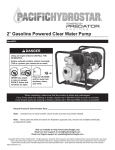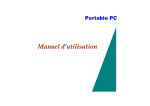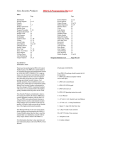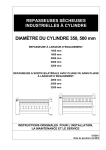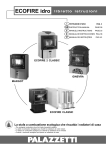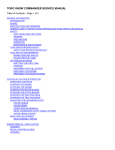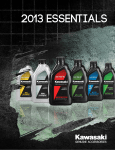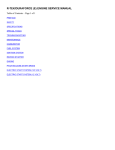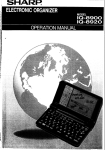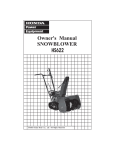Download Honda WB 15 User's Manual
Transcript
Thank you for purchasing a Honda water pump. We want to help you get the best results from your new water pump and to operate it safely. This manual contains the information on how to do that; lease read it carefully. ? his manual covers the operation and maintenance of Honda water pump: WB15 All information in this publication is based on the latest roduct information available at the time of printing. Honda Motor 8 o., Ltd. reserves the right to make changes at any time without notice and without incurring any obligation. No part of this publication may be reproduced without written permission. This manual should be considered a permanent part of the water ump and should remain with it if it is resold. Pt is ille al in some areas to operate an engine without a U.S.D.A. qualifie 3 spark arrester: Check local laws and regulations. An optional spark arrester for this water pump is available from your authorized Honda water pump dealer. Safety Messages Your safety and the safety of others is very important. We have provided important safety messages in this manual and on the water pump. Please read these messages carefully. A safety message alerts you to potential hazards that could hurt you or others. Each safety message is receded by a safety alert symbol A and one of three words: DAN 0 ER, WARNING, or CAUTION. These mean: m You WILL be KILLED or SERIOUSLY HURT if you don’t follow instructions. m You CAN be KILLED or SERIOUSLY HURT if you don’t follow instructions. ,m You CAN be HURT if you don’t follow instructions. Each message tells you what the hazard is, what can happen, what you can do to avoid or reduce injury. Damage Prevention Messages You will also see other important word NOTICE. This word means: [ Your water pump you don’t follow instructions. messages that are preceded or other property and by the could be damaged The purpose of these messages is to help prevent water pump, other property, or the environment. damage if to your 1 CONTENTS 1. 2. 3. 4. 5. 6. 7. 8. 9. 10. 11. 12. 2 WATER PUMP SAFETY.. ..................................................................... COMPONENT IDENTIFICATION.. ....................................................... PREPARATION ..................................................................................... STARTING THE ENGINE ................................................................... OPERATION ....................................................................................... STOPPING THE ENGINE ................................................................... 0 High altitude operation ................................................................. MAINTENANCE ................................................................................. .............................................................. TRANSPORTING/STORAGE TROUBLESHOOTING ........................................................................ SPECIFICATIONS.. ............................................................................. CUSTOMER SERVICE INFORMATION.. .............................. . ............ INDEX ................................................................................................. .3 .5 .6 .I1 .I3 .I4 .I5 .I6 21 .24 .26 .27 .28 1. WATER PUMP SAFETY To ensure safe operation - For safety, never pump flammable or corrosive liquids such as gasoline or acid. Also, to avoid pump corrosion, never pump sea water, muddy water, chemical solutions, or caustic liquids such as used oil, wine, or milk. . Operate the pump on a level surface. If the engine is tilted, fuel spillage may result. l To prevent fire hazards and to provide adequate ventilation, keep the pump at least 1 meter (3 feet) away from building walls and other equipment during operation. Do not place flammable objects close to the pump. l Do not allow children to operate the pump. Keep children and pets away from the area of operation. l Know how to stop the pump quickly, and understand the operation of all controls. Never permit anyone to operate the pump without proper instructions. l Gasoline is extremely flammable and is explosive under certain conditions. - Refuel in a well-ventilated area with the engine stopped. Do not smoke or allow flames or sparks in the area where the engine is refueled or where gasoline is stored. - Do not overfill the fuel tank (there should be no fuel in the filler neck). After refueling, make sure the tank cap is closed properly and securely. l Be careful not to spill fuel when refueling. Spilled fuel or fuel vapor may ignite. If any fuel is spilled, make sure the area is dry before starting the engine. l Never run the engine in an enclosed or confined area. Exhaust gas contains poisonous carbon monoxide gas; exposure can cause loss of consciousness and may lead to death. l The muffler becomes very hot during operation and remains hot for a while after stopping the engine. Be careful not to touch the muffler while it is hot. Let the engine cool before storing the pump indoors. l A spark arrester is available as an optional part for this pump. It is illegal in some areas to operate an engine without a spark arrester. Check local laws and regulations before operating. l Exhaust gas contains poisonous carbon monoxide. Avoid inhalation of exhaust gas. Never run the pump in a closed garage or confined area. l 3 SAFETY LABEL LOCATIONS The labels shown here contain important safety information. Please read them carefully. These labels are considered permanent parts of your water pump, so if a label comes off or becomes hard to read, contact your authorized Honda water pump dealer for a replacement. ,WARNlNGp DO NOT PUMP FLAMMABLE OR CORROSIVE MATERIALS. AN EXPLOSION OR FIRE COULD RESULT, CAUSING SEVERE PERSONAL INJURY. WARNING! DO NOT RUN WITHOUT PRIMING WATER. DRY OPERATION WILL BURN THE SEAL. ACHTUNG! VORDEMANLAUFEN BEI TESTUND LEERLAUF GEHAUSE MIT WASSER BEFliLLEN TROCKEN AUF ZERSTORT DIE DICHTUNGEN:. ATENCION! NO HAGA FANCIONAR SIN CEBADO FUNCIONAMIENTO SEC0 QUEMA EL SELLO. ATTENSION! NE FAITE PAS FONCTIONNER SANS AMORSAGE. FANCTIONNEMENT AU SEC BRULE LE JOINT D’ETANCHEITE. 4 2. COMPONENT CARRYING HANDLE IDENTIFICATION FUEL FILLER CAP CHOKE LEVER FUEL VALVE AIR CLEANER STARTER GRIP \ DISCHARGE PORT q ENGINE SWITCH \ THROlTLE LEVER PRIMING WATER FILLER CAP MUFFLER ENGINE SERIAL NUMBER SUCTION PORT OIL FILLER CAP/DIPSTICK PUMP DRAIN PLUG OIL DRAIN PLUG *Record the engine serial number for your future reference. Refer to this serial number when ordering parts, and when making technical or warranty inquiries (see page 27 ) Engine serial number: 5 3. PREPARATION 1. Suction hose Use a commercially available hose, hose connector, and hose bands. The suction hose must be of reinforced, noncollapsible wall or wire braided hose to prevent suction collapse. The suction hose length should not be longer than necessary, as the pump performance is best when the pump is not far above the water level. Self-priming time is also proportional to the suction hose length. Using a longer suction hose will increase the self-priming time. The strainer is provided with the pump and should be attached to the end of the suction hose with a band as shown. [I Always install the strainer on the end of the suction hose before pumping. The strainer will prevent debris from entering the pump that can cause clogging or pump damage. STRAINER (OPTION) SUCTION HOSE 2. Discharge hose Use a commercially available hose, hose connector, and hose band. A short, large-diameter hose is most efficient. A long or small-diameter hose increases fluid friction and reduces pump output. Tighten the disconnecting hose band securely under high pressure. to I I DISCHARGE HOSE BAND 6 HOSE prevent the hose from 3. Engine oil [NOTlCE] l l Engine oil is a major factor affecting engine performance and service life. Nondetergent oils and P-stroke oils are not recommended because they have inadequate lubricating characteristics. Check the oil level with the pump on a level surface and the engine stopped. Use Honda 4-stroke oil, or an equivalent high detergent, premium quality motor oil certified to meet or exceed U. S. automobile manufacturer’s requirements for Service Classification 0 20 40 , 60 80 1OO'F SG, SF. Motor oils classified SG, SF TEMP-20 -30 -20 -10 0 10 20 30 4O'C will show this designation on the conAMBIENT TEMPERATURE tainer. SAE lOW/30 is recommended for general, all-temperature use. Other viscosities shown in the chart may be used when the average temperature in your area is within the indicated range. 1. Remove the oil filler cap/dipstick and wipe it clean. 2. Insert the filler cap/dipstick into the oil filler neck, but do not screw it in. 3. If the level is low, fill to the top of the oil filler neck with the recommended oil. piEiq Running damage. ( the engine with insufficient oil can cause serious engine UPPER LIMIT DIPSTICK 7 Fuel Recommendation 1. Remove the filler cap check fuel level. level is low. Do not fill above the shoulder of the fuel strainer. 2. Refill the tank if the fuel l l l l l Gasoline is extremely flammable and is explosive under certain conditions. Refuel in a well-ventilated area with the engine stop ed. Do not smoke or allow flames or sparks in the area where t Ii e engine is refueled or where gasoline is stored. Do not overfill the fuel tank (there should be no fuel in the filler neck). After refueling, make sure the tank cap is closed properly and securely. Be careful not to spill fuel when refueling. Spilled fuel or fuel vapor may ignite. If any fuel is spilled, make sure the area is dry before starting the engine. Avoid repeated or prolonged contact with skin or breathing of vapor. KEEP OUT OF REACH OF CHILDREN. Fuel tank capacity: 1.4 0 (0.37 US gal, 0.31 Imp gal) MAXIMUM FUEL LEVEL Use unleaded gasoline with a pump octane rating of 86 or higher. asoline. This engine is designed to operate on unleaded Unleaded gasoline produces fewer engine an 1 spark plug deposits and extends exhaust system life. piieiq Fuel can dama e paint and some types of plastic. Be careful not to spill fuel when 9illing your fuel tank. Damage caused by spilling fuel is not covered under warranty. asoline Never use stale or contaminated Avoid getting dirt or water in the fue 7 tank. 8 I or oil/gasoline mixture. Occasionally you may hear light “spark knock” or “pinging” (metallic rapping noise) while operating under heavy loads. This IS no cause for concern. If spark knock or pin ing occurs at a steady engine speed, under normal load, change %rands of gasoline. If spark knock or pinging persists, see an authorized Honda water pump dealer. Is ,/ piimq Running the engine with persistent engine damage. spark knock or pinging can cause Running the engine with persistent spark knock or pinging is misuse, and the Distributor’s Limited Warranty does not cover parts damaged by misuse. Oxygenated Fuels Some conventional gasolines are being blended with alcohol or an ether compound. These gasolines are collectively referred to as oxygenated fuels. To meet clean air standards, some areas of the United States and Canada use oxygenated fuels to help reduce emissions. If you use an oxygenated fuel, be sure it is unleaded and meets the minimum octane rating requirement. Before using an oxygenated fuel, try to confirm the fuel’s contents. Some states/provinces require this information to be posted on the ? 1: Pdllowing ETHANOL MTBE - METHANOL are the EPA approved percenta es of oxygenates: - (ethyl or grain alcohol) 10% %y volume You may use asoline containing up to 10% ethanol by volume. l! asoline containing ethanol may be marketed under the name “Gasohol”. (methyl tertiary butyl ether) 15% by volume $rrzy use gasoline contarnrng up to 15% MTBE by - @;th$;r wood alcohol) 5% by vo!ume use gasoline containing up to 5% methano Y by volume as long as it also contains cosolvents and corrosion inhibitors to protect the fuel system. Gasoline containing more than 5% methanol by volume may cause starting and/or performance problems. It may also damage metal, rubber, and plastic parts of your fuel system. If you notice any undesirable operating symptoms, try another service station or switch to another brand of gasoline. Fuel system dama e or performance problems resulting from the use of an oxygenate 2 fuel containing more than the percentages of oxygenates mentioned above are not covered under warranty. 9 4. Air cleaner Loosen the wing nut and remove the air cleaner cover. Check the air cleaner element to be sure it is clean and in good condition. Clean or replace the element if necessary (p. 18 1. AIR CLEANER ELEMENT AIR CLEANER COVER WING NUT Never run the engine without the air cleaner. Rapid engine wear will result from contaminants, such as dust and dirt being drawn into the engine. 5. Priming water The pump chamber should be completely filled before operating. I Do not operate the pump without priming water or the pump will overheat. Operating the pump dry will destroy the pump seal. If the unit has been operated dry, stop the engine immediately and allow the pump to cool before adding priming water. TER 4. STARTING THE ENGINE 1 .Turn the fuel valve ON. 2. Close the choke lever. Do not use the choke if the engine is warm or the ambient temperature is high. FUEL VALVE CHOKE LEVER ON 3. Turn the engine switch to the ON position. ENG!NE SWITCH 11 4. Move the throttle lever downward slightly, just past the idle position. THROlTLE 5. Pull the starter grip lightly until resistance LEVER is felt, then pull it briskly. I I Do not allow the starter grip to snap back against the engine. it slowly to prevent damage to the starter. 12 Return 5. OPERATION 1. As the engine warms up, gradually open the choke. CHOKE LEVER 2. Set the throttle at the desired speed. LEVER 13 I 6. STOPPING THE ENGINE In an emergency: l.To stop the engine OFF position. in an emergency, turn the engine ENGINE SWITCH In normal use: 1. Move the throttle lever all the way up. 2. Turn the engine switch to the OFF position. 3. Turn the fuel valve OFF. FUEL VALVE 14 switch to the High altitude operation At high altitude, the standard carburetor air-fuel mixture will be too rich. Performance will decrease, and fuel consumption will increase. A very rich mixture will also foul the spark plug and cause hard starting. High altitude performance can be improved by specific modifications to the carburetor. If you always operate your pump at altitudes above 6,000 feet (1,800 meters) have an authorized Honda water pump dealer perform this carburetor modification. If any case, engine horsepower will decrease 1,000 foot (300 meter) increase in altitude. about 3.5% for each pi6E-j When the carburetor has been modified for high altitude operation, the air-fuel mixture will be too lean for low altitude use. Operation at altitudes below 6,000 feet (1,800 meters) with a modified carburetor may cause the engine to overheat and result in serious engine damage. For use at low altitudes, have an authorized Honda water pump dealer return the carburetor to original factory specifications. 15 7. MAINTENANCE The purpose of the Maintenance Schedule is to keep the pump in the best operating condition. Inspect and service as indicated in the Maintenance Schedule below. Shut off the engine must be operated, contains poisonous consciousness and before performing any maintenance. If the engine make sure the area is well-ventilated. The exhaust carbon monoxide gas; exposure can cause loss of may lead to death. pciq Use only genuine HONDA parts or their equivalent for maintenance or repair. Replacement parts which are not of equivalent quality may damage the pump. Maintenance Schedule I 012) every 2 years (Replace if necessary) Fuel tank cleaning Fuel line (2) (2) O(2) Impeller inspection Casing cover inspection Inlet valve inspection NOTE: (1) Service more frequently 0 0 when used in dusty areas. (2)These items should be serviced unless the owner has the proper Honda 16 Shop Manual. by an authorized Honda tools and is mechanically water pump dealer, proficient. See the 1. Changing oil Drain the oil while complete draining. the engine is still warm to assure rapid and 1. Remove the oil filler cap/dipstick and the drain plug to drain the oil. 2. Reinstall the drain plug and tighten securely. 3. Refill with the recommended oil (see page 7 1 to the specified level. OIL CAPACITY: 0.45 0 (0.48 US qt ,0.40 Imp qt) OIL FILLER CAP/ DIPSTICK Please dispose of used motor oil in a manner that is compatible with the environment. We suggest you take it in a sealed container to your local recycling center or service station for reclamation. Do not throw it in the trash or pour it on the ground. 2. Air cleaner service A dirty air cleaner will restrict air flow to the carburetor. To prevent carburetor malfunction, service the air cleaner regularly. Service more frequently when operating the pump in extremely dusty areas. B Never use gasoline or low flash point solvents cleaner element. A fire or explosion could result. for cleaning the air pizEiEq Never run the engine without the air cleaner. Rapid engine wear will result from contaminants, such as dust and dirt being drawn into the engine. 1. Unscrew the wing nut, remove the air cleaner cover and remove the foam element. 2. Wash the element in a solution of household detergent and warm water, then rinse thoroughly, or wash in nonflammable or high flash point solvent. Allow the element to dry thoroughly. 3. Soak the element in clean engine oil and squeeze out the excess oil. The engine will smoke during initial start-up if too much oil is left in the element. 4. Reinstall the air cleaner element and the cover. 18 3. Spark plug service Recommended spark plug: BPM-4A, BPMR4A To ensure proper engine operation, gapped and free of deposits. (NGK) the spark plug must be properly 1. Remove the spark plug. B The muffler becomes very hot during operation and remains hot for a while after stopping the engine. Be careful not to touch the muffler while it is hot. 2.Visually inspect the spark plug. Discard it if the insulator is cracked or chipped. Clean the spark plug with a wire brush if it is to be reused. 3. Measure the plug gap with a feeler gauge. Correct as necessary by bending the side electrode. The gap should be: 0.60-0.70 mm (0.024-0.028 in) 0.60-0.70 mm (0.024-0.028 in) 19 4.Check that the spark plug washer is in good condition, the spark plug in by hand to prevent cross-threading. 5.After the spark plug is seated, tighten compress the washer. and thread with a spark plug wrench to -If installing a new spark plug, tighten l/2 turn after the spark plug seats to compress the washer. - If reinstalling a used spark plug, tighten l/8- l/4 turn after the spark plug seats to compress the washer. 1 NOTICE l l ( The spark plug must be securely tightened spark plug can become very damage. Use only the recommended spark plug which has an improper heat range may 20 tightened. An improperly hot and may cause engine or equivalent. A spark plug cause engine damage. 8.TRANSPORTING/STORAGE When transporting the water pump, turn the engine switch and the fuel valve OFF. Keep the water pump level to prevent fuel spillage. Fuel vapor or spilled fuel may ignite. Contact with a hot engine or exhaust system can cause serious burns or fires. Let the engine cool before transporting or storing the water pump. Before storing the pump for an extended period; 1. Be sure the storage area is free of excessive humidity and dust. 2. Clean the pump interior..... Sediment will settle in the pump if it has been used in muddy or sandy water, or water containing heavy debris. Pump clean water through the pump before shutting down or the impeller may be damaged when restarting. After flushing, remove the pump drain plug, and drain as much water as possible from the pump housing. After the pump is dry, spray HONDA MULTI PURPOSE LUBE AND RUST PENETRANT into the pump housing through the inlet port, outlet port, and drain hole, then install the drain plug. DRAIN PLUG 21 3. Service the fuel system according to the table below: Gasoline is extremely flammable and is explosive under certain conditions. Perform this task in a well-ventilated area with the engine stopped. Do not smoke or allow flames or sparks in the area during this procedure. a. With the fuel valve OFF, remove SEDIMENT CUP the carburetor drain screw. b.Drain the gasoline from the carburetor into a suitable container. c. If the tank is to be drained, turn the fuel valve ON and drain the fuel in the tank into a suitable container. d.Reinstall the drain screw and turn the fuel valve OFF. STORAGE TIME RECOMMENDED SERVICE PROCEDURE TO PREVENT HARD STARTING Less than 1 month No preparation 1 to 2 months Fill with fresh gasoline conditioner *. 2 months to 1 year 1 year or more required Fill with fresh gasoline and add gasoline conditioner *. Drain the carburetor float bowl. Fill with fresh gasoline and add gasoline conditioner *. Drain the carburetorfloat bowl. After removal from storage, drain the stored gasoline into a suitable container, and fill with fresh gasoline before starting. *Use gasoline conditioners that are formulated life. Contact your authorized Honda water recommendations of gasoline conditioners. 22 and add gasoline to extend storage pump dealer for 4.Remove the spark plug, and pour about a tablespoon of clean engine oil into the cylinder. Crank the engine several revolutions to distribute the oil, then reinstall the spark pulg. 5.Slowly pull the starter grip until resistance is felt. At this point, the piston is coming up on its compression stroke and both the intake and exhaust valves are closed.Storing the. engine in this position will help to protect it from internal corrosion. 6. Change the engine oil (see page 17). 7. Check the air cleaner and clean as necessary (see page 18). 8. Cover the water pump to keep out dust. 23 9. TROUBLESHOOTING When the engine will not start: 1. Is the engine switch ON? 2. Is there fuel in the fuel tank? 3. Is the fuel valve ON? 4. Is gasoline reaching the carburetor? To check, remove the float bowl drain screw and turn the fuel valve ON. Fuel should flow out freely. B If any fuel is spilled, make sure the area is dry before testing the spark plug or starting the engine. Spilled fuel or fuel vapor may ignite. DRAIN SCREW 5. Is there a spark at the spark plug? a. Remove the spark plug cap. Clean any dirt from around the spark plug base, then remove the spark plug. b. Install the spark plug in the plug cap. c. Turn the engine switch ON. d.Ground the side electrode to any engine ground, pull the recoil starter to see if sparks jump across the gap. e. If there are no sparks, replace the plug. If OK, install the plug and try to start the engine. 6. If the engine still does not start, take the pump to an authorized Honda water pump dealer. 24 When the pump does not pump water: I. Is the pump fully primed? 2. Is the strainer clogged? 3. Are the suction hose bands installed securely? 4. Is the suction hose damaged? 5. Is the suction hose connector washer installed? 6. Is the suction head too high? 7. If the pump still does not pump the water, take the pump authorized Honda water pump dealer. to an 25 IO. SPECIFICATIONS Dimensions and Weight Length Width Height Dry weight 335 270 350 13.0 mm (13.2 in) mm (10.6 in) mm (13.8 in) kg (28.7 Ibs) Engine Model Engine type Displacement [Bore X Stroke] Max. output Max. torque Cooling system Ignition system PTO shaft rotation GIOO K2 4-stroke, side valve, 1 cylinder 97 cm3 (5.9 cu-in) 52 x 46 mm (2.0 x 1.8 in) 1.8 kW (2.5 PS, 2.5 bhp) at 4,200 rpm 4.5 Nom (0.45 kg-m, 3.3 ft-lb) at 3,000 rpm Forced air Transistorized magneto Counterclockwise Pump Suction port diameter Discharge port diameter Rated revolutions Total head Suction head Capacity Self-priming time 26 38 mm (1.5 in) 38 mm (1.5 in) 3,800 rpm 38 m (124.7 ft) 7 m (23.0 ft) 200 !J (52.8 US gal, 44.0 Imp gal)/min 120secat5m(16.5ft) 11. CUSTOMER SERVICE INFORMATION Honda power equipment dealership personnel are trained professionals. They should be able to answer any question you may have. If you encounter a problem that your dealer does not solve to your satisfaction, please discuss it with the dealership’s management. The Service Manager or General Manager can help. Almost all problems are solved in this way. If you are dissatisfied with the decision made by the dealership’s management, contact the Honda Power Equipment Customer Service Office. You can write to: American Honda Motor Co., Inc. Honda Power Equipment Division Customer Service Office 4475 River Green Parkway Duluth, Georgia 30136-2565 Or telephone: (404)497-6400 When you write or call, please give us this information: l Model and serial number (see page 5 ) l Name of dealer who sold the water pump to you l Name and address of dealer who services your water pump l Date of purchase l Your name, address, and telephone l A detailed description number of the problem 27 12. INDEX COMPONENT IDENTIFICATION ................................................................. CUSTOMER SERVICE INFORMATION ................................................... MAINTENANCE ........................................................................................ Air cleaner service ................................................................................ Changing oil ........................................................................................... Spark plug service ................................................................................ OPERATION .............................................................................................. High altitude operation ........................................................................ PREPARATION ............................................................................................. Air cleaner .............................................................................................. Discharge hose ........................................................................................ Engine oil .................................................................................................. ............................................................................. Fuel recommendation ......................................................................................... Priming water Suction hose ............................................................................................ STARTING THE ENGINE .......................................................................... SPECIFICATIONS ....................................................................................... STOPPING THE ENGINE.. ........................................................................ .................................................................. TRANSPORTING/STORAGE.. TROUBLESHOOTING.. ............................................................................. WATER PUMP SAFETY.. ............................................................................ 28 5 .27 .I6 .I8 17 .I9 .I3 .I5 6 10 6 7 8 10 6 .I1 26 .I4 .21 .24 .3

































